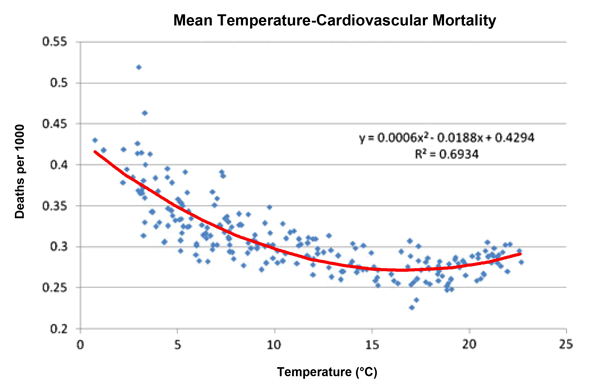Reference
Fernandez-Raga, M., Tomas, C. and Fraile, R. 2010. Human mortality seasonality in Castile-Leon, Spain, between 1980 and 1998: the influence of temperature, pressure and humidity. International Journal of Biometeorology 54: 379-392.
What was done
Working in the Castile-Leon region of Spain -- a plateau in the northwestern part of the country that includes nine provinces "with a low population density that can be considered as ageing" -- the authors obtained (from the country's National Meteorological Institute) meteorological data from weather stations situated in eight of the provincial capitals that covered the period 1980-1998, while they obtained contemporary mortality data from the country's National Institute for Statistics for deaths associated with cardiovascular, respiratory and digestive system diseases.
What was learned
Various analyses of the monthly-averaged data revealed a number of interesting results. First, for all three of the disease types studied, Fernandez-Raga et al. found that "the death rate is about 15% higher on a winter's day than on a summer's day," which they describe as "a result often found in previous studies," citing the work of Fleming et al. (2000), Verlato et al. (2002), Grech et al. (2002), Law et al. (2002) and Eccles (2002).
Second, in a finding that helps explain the first finding, the three researchers discovered that when monthly-averaged human death rates were plotted against monthly-averages of daily mean, maximum and minimum air temperature, the results nearly always took the form of a U-shaped concave parabola. And for all three disease types, they found that all three temperatures (daily mean, maximum and minimum) at which minimum death rates occurred -- which they refer to as ideal or comfort temperatures -- were all within about 1-7°C of the maximum values typically reached by those three types of temperature, while they were anywhere from 14-24°C away from their minimum values. Consequently, the ideal or comfort temperatures were always very close to (and sometimes nearly identical to) the maximum values reached by the mean, maximum and minimum temperatures experienced in the region, while they were much more removed from the minimum values of those three temperature parameters, as illustrated in the figure below that relates death rates due to cardiovascular diseases to mean air temperature.

Figure 1. Monthly deaths in the Castile-Leon region of Spain attributable to cardiovascular disease. Adapted from Fernandez-Raga et al. (2010).
What it means
The data of Figure 1 clearly demonstrate that the people of the Castile-Leon region of Spain are much more likely to die from a cardiovascular disease in the extreme cold of winter than in the extreme heat of summer. And the same holds true with respect to dying from respiratory and digestive system diseases: cold is a much greater killer of people than heat is almost everywhere in the world, as may readily be verified by perusing the reviews of numerous studies of the subject that have been conducted around the globe and that we have archived in our Subject Index under the general heading of Mortality (Hot vs. Cold Weather).
References
Eccles, R. 2002. An explanation for the seasonality of acute upper respiratory tract viral infections. Acta Oto-Laryngologica 122: 183-191.
Fleming, D.M., Cross, K.W., Sunderland, R. and Ross, A.M. 2000. Comparison of the seasonal patterns of asthma identified in general practitioner episodes, hospital admissions, and deaths. Thorax 55: 662-665.
Grech, V., Balzan, M., Asciak, R.P. and Buhagiar, A. 2002. Seasonal variations in hospital admissions for asthma in Malta. Journal of Asthma 39: 263-268.
Law, B.J., Carbonell-Estrany, X. and Simoes, E.A.F. 2002. An update on respiratory syncytial virus epidemiology: a developed country perspective. Respiratory Medicine Supplement B 96: S1-S2.
Verlato, G., Calabrese, R. and De Marco, R. 2002. Correlation between asthma and climate in the European Community Respiratory Health Survey. Archives of Environmental Health 57: 48-52.
Reviewed 29 September 2010



